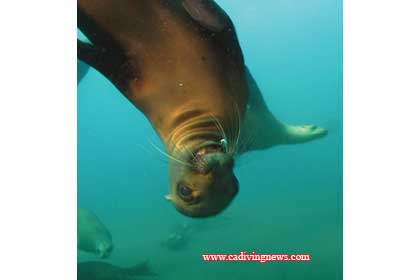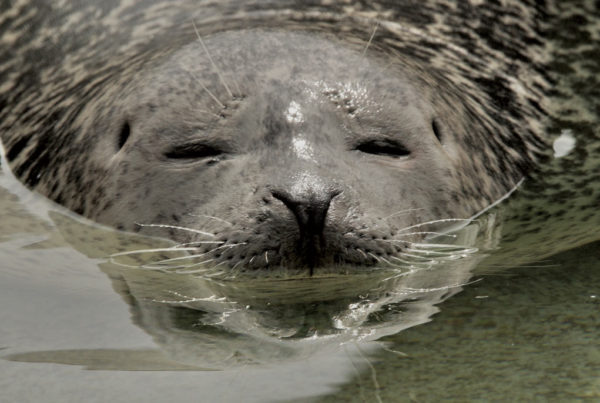The California seas are full of marine animals that can be a challenge to photograph. Personally, for me one of the most difficult is the sea lion. They are fast and they are dark. And they are smart. Back in the day I burned a lot of film on these funny guys. I have had a bit more luck with digital, but that is only because of the ever-present friend of the underwater electronic photographer: the delete button.
I have met some excellent underwater photographers that have shared tricks of the trade with me, and using those I have come up with some of my own. Below are a few tips that will help you capture quality images of this often-comical creature in his acrobatic antics.
FINDING THEM
Actually, it is more like them finding you. At any given time you can be dive bombed in the California oceans by a sea lion. But if your specific goal is sea lion underwater photography, there are several locations along California coastline and especially out at the offshore islands where you will dramatically increase your odds of an encounter. Sea lions use two types of locations to aggregate in large numbers. The first is what is known as a “haul-out.” This is where the sea lions waddle themselves ashore to rest and warm their bodies. These gatherings can be just a handful of sea lions or as many as a hundred. Haul-outs are numerous but some of the more noteworthy locations include the Coronados Islands (just south of San Diego in Mexican waters), Seal Rocks at Crescent Bay in Laguna Beach, Seal Rocks off the East end of Catalina Island, the backside of the east island of Anacapa Island (a rather large haul-out), and the breakwater at Monterey.
The second type is a rookery. Rookeries are very large assemblies of animals and it is where they mate and give birth and begin to raise their young. While haul-outs are a good spot to dive with sea lions, rookeries are excellent and almost always assure the diver of an exciting encounter.
The two rookeries in the Channel Islands are at Santa Barbara Island and at San Miguel Island. Santa Barbara Island is the rookery most often visited by divers. Good dive charter boats serving these areas, haul-outs or rookeries, will be able to drop you right into the thick of them during optimal water conditions.
YOUR ENCOUNTER
Getting the attention of sea lions is easy — just drop in and start blowing bubbles and they will zip right in. It is the youth that are the most curious. At first they will simply investigate, then show off acrobatics and sometime they will rush at you blowing bubbles in your face pulling up at the last minute. Sometimes they will bite at fins and strobes but do not offer them a hand as you will likely get bit. While unlikely to hurt, you never know. Females are bigger and sometimes join in the fun and not dangerous. The adult males, exceptionally large with humped heads, rarely participate, but if one shows up, you are in his territory and it might be best to retreat.
Young sea lions get bored easily and your trick is to maintain their interest. Often just the flash of your strobe and its whine as it powers up is enough to keep their attention but you may have to do more. Spin and twist as they do (or have your buddy play the fool and do it). Pick a rock or shell and throw it up and they may retrieve it for you. Underwater noisemakers and lights work well also. Never attempt to feed them.
PHOTOGRAPHY
A wide-angle lens is best but a normal lens on a point and shoot will work just as well. A supplemental strobe is a must as sea lions have dark fur that absorbs light. The small strobe on the camera itself will just not cut it. The more powerful the strobe the better and two strobes are best.
Odds are you will be photographing the sea lions on a shallow sandy bottom. They often stir up the bottom in their play so keep in mind that backscatter can a problem. Adjust your strobes in a wide stance.
Balance your photos so the background is lit but plan on overpowering the flash on the sea lion double or more to get the texture and color of their fur, otherwise your photo could be just a black blur. A fast shutter speed is required to capture their antics so bump up your ISO to at least 200 or more depending on the available light. A shutter speed of at least 1/125 is best, but be sure to check the flash sync speed of your camera. It is a lighting balance that takes time to master on any particular day as the available light will impact greatly on your shot.
Speaking of available light, a great place to photograph a group of playful young sea lions is on the surface. Snorkel with them. They will congregate there, seemingly planning out their next strategy of attack on the divers below. Up above they will hold still a bit longer just below the surface and with available light photos are easy.
Photographing the sea lions as they swoop by is a challenge you are simply going to have to take a lot of pictures. Think of yourself photographing a race car zooming past you as you stand still. Track your target as you shoot your frame. Your background may be blurred but your sea lion will be sharp. Besides, a blurred background will give the image a dynamic of speed.
Occasionally, they will pause, just for a second or two, usually on the bottom, and just “smile” at you. This is your opportunity for a classic face shot. Relax, take your time and if possible spend an entire dive concentrating on just sea lion photos. They will come to you in curiosity trying to understand this strange creature with a funny flashing contraption attached to its face.









